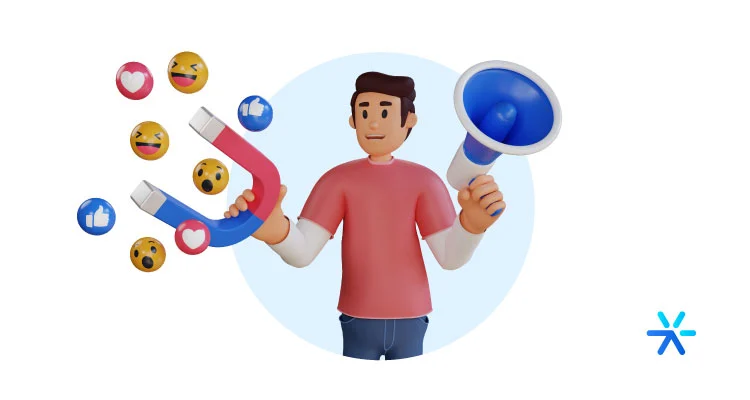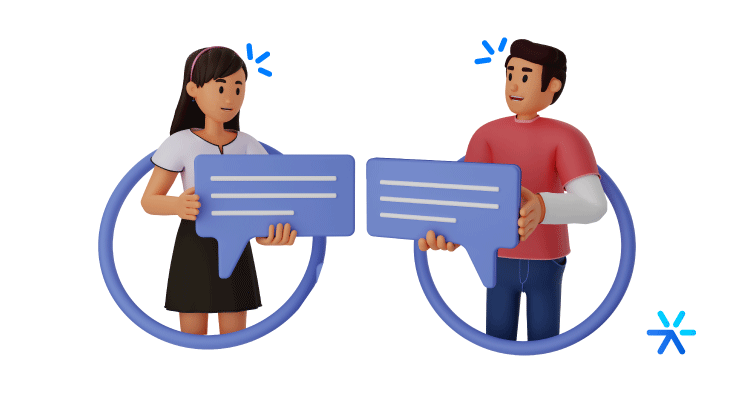MQL and SQL: What They Are and How to Classify Your Leads in 2024
MQL? SQL? If you’re structuring or rethinking your lead generation strategy, you’ve probably come across these acronyms at some point, right?
This type of classification serves to identify the stage at which the lead is in the sales funnel, in relation to their qualification for purchase.
In today’s article, we’ll explain what each of these terms means, their role within the sales funnel, and how to perform this type of classification for a comprehensive marketing and sales plan.
What you’ll explore in this article:
- MQL and SQL are different stages of leads within the sales funnel and are related to the consumer’s purchasing maturity.
- MQL stands for Marketing Qualified Lead, meaning a marketing-qualified lead, one who has already received educational materials and is aware of the problem but is not yet considering brand options.
- SQL stands for Sales Qualified Lead, meaning a sales-qualified lead, one who has chosen a solution and is close to completing the purchase.
- To identify whether a lead is MQL or SQL, it is necessary to map out the buyer’s journey of the personas and understand how they deal with the acquisition process.
- The classification of MQL and SQL is important to define the appropriate approach for each stage of the buyer’s journey and for a comprehensive marketing and sales plan.
Let’s begin:
What’s the difference between MQL and SQL?

MQL and SQL are different stages of leads within the sales funnel and are related to the consumer’s purchasing maturity.
A sales conversion that becomes a lead is nurtured and qualified through marketing strategy until it is ready to be passed on to the sales strategy.
Therefore, the difference between MQL and SQL is the level of qualification, and SQL is an evolution of MQL.
In practical terms, understanding the type of qualification of each lead is important to define the approach that will be taken with them, ensuring it’s ideal for where they are in the buyer’s journey.
What is MQL?
MQL stands for Marketing Qualified Lead, meaning a marketing-qualified lead.
An MQL is a contact who has already received educational materials and is aware of the problem they have.
They are also a contact who is starting to understand what type of solution is ideal for solving their problem.
However, they are not yet thinking about the brand options that will be chosen to solve this pain point.
They are not yet at this stage of purchase and, therefore, still need to be nurtured within the marketing strategy with materials that direct interest and present the solution your company offers.
What is an Outbound MQL?
In addition to the MQL we just defined above, in marketing and sales, you will also work with Outbound MQL.
In this concept, we’re talking about that potential customer who has already contacted your company but has not yet made the purchase.
The difference between MQL and Outbound MQL is “how” each one came to your business. The latter was approached by active prospecting since this is the basis of an outbound marketing strategy, meaning someone from your team reached out, introduced themselves, and offered a resource.
What is a SQL?
SQL, on the other hand, is the lead qualified in the sales cycle (or Sales Qualified Lead).
It is the next stage after MQL and is a lead closer to completing the purchase because they have chosen a solution your company offers.
For this reason, it is a contact that should be worked on within the company’s sales strategies.
Here, the sales team takes action to engage with an audience that is ready to decide which brand will solve their problem.
How to determine if it’s really an MQL or SQL?

There are some criteria that help us determine when a lead is MQL and when it is SQL.
These criteria also work to understand the change in qualification between the first and second segmentation types.
The first step to know if the lead is MQL or SQL is to map out and analyze the buyer’s journey of your personas. Only then will you understand how they deal with the solution acquisition process, product, or service your company offers at the bottom of the sales funnel.
To help with this understanding, we’ve listed some criteria you can analyze to determine if the lead is MQL or SQL. Check them out:
- Professional information: job title, sector, company size, etc. These data help identify if the lead is more likely to qualify as MQL or SQL.
- Engagement: eBook downloads, webinar attendance, event participation, among others, can indicate if the lead is further along in the buyer’s journey and qualifies as MQL.
- Behavior: actions such as visited pages and time spent tend to indicate if the lead is truly interested and qualifies as MQL.
- Lead scoring: you can assign points to leads based on their actions and characteristics; we’ll talk more about this soon.
- Feedback: questions asked to the lead, such as the need for a solution, budget, and timeline, serve as an indication to determine if the lead is ready to be approached by the sales team.
What is a SAL in sales?
Between MQL and SQL, we have a middle-ground classification: the Sales Accepted Lead (SAL).
This is the lead that, based on their interaction history, is ready to move to the sales department. The team itself gives the “OK” for users to move forward, based on criteria that have also been defined.
Why is qualifying a lead important?

From the “data doesn’t lie” series, some studies have already proven the advantages of qualifying a lead.
Among them, we can mainly mention the State of Lead Management research by Marketo: the report indicated that companies that classify leads based on their buying maturity have a 50% higher conversion rate than those that do not.
In addition to boosting the conversion rate, a lead qualification system helps teams understand what type of content and approach to use with users at each stage of the journey.
Finally, you can also explore tools to track lead progress through the funnel, creating hooks that aid in contact segmentation.
Benefits of Generating Qualified Leads

Among the main benefits of lead qualification are:
Saves time and resources ⏳
The sales team focuses their efforts on leads that are already better prepared to close a deal.
That is, sales time and resources are used on consumers who are more likely to buy, and marketing time and resources can also be better allocated to prepare leads who have not yet reached this stage.
Increases the conversion rate of the sales team 📈
If the sales team is working with contacts with a higher intent to purchase, this also means that conversion rates will be optimized.
By addressing potential consumers at the right time, the chances of closing a purchase or contract are much higher.
How to classify MQLs and SQLs in your campaign?

Now that you know what MQLs and SQLs are, let’s move on to the practical aspect of classifying these opportunities within your strategy.
Know your persona well
Your brand’s personas are representations of the ideal customers for the solution your company offers.
Through the design of personas, you’ll be able to create quality materials that align with your consumer’s challenges, pains, and goals.
Without understanding these points, communication becomes superficial, and lead qualification becomes even more limited.
Implement lead scoring
The lead scoring process is one of the most well-known for lead qualification in practice.
With it, you can map conversion triggers, and each lead action receives a score.
By assigning points to each lead interaction with the sales funnel, the points add up, and upon reaching a predetermined number of points, the lead moves to the next qualification stage.
Lead scoring can be used for both MQL and SQL marking.
Track Leads Through the Funnel
Throughout the lead management process, it’s important to monitor and track metrics.
In addition to tracking the number of leads and sales generated throughout the development of your actions, we recommend that you also track the number of qualified leads at each stage of the funnel.
This way, you monitor how many leads are qualified for marketing and how many leads are qualified for sales, ensuring the funnel is balanced and also understanding which actions bring more results.
You may also be interested in: Customer Acquisition Cost: What It Is and How to Reduce CAC
Request feedback from the sales team
No one knows better than your frontline team to validate the lead qualification process.
For this reason, stay in touch with employees and leaders of sales teams and understand how the arrival of leads to them is impacting their work.
Do they feel that consumers are coming with fewer doubts?
Is the argumentation process simplified?
Are the results proving effective?
Have the conversion rates of qualified leads to customers improved?
All these questions will help align, monitor, and refine the strategy.
Read also: Sales Support: What It Is and How to Use It to Sell More
Always adjust the process
Your lead generation and qualification strategy cannot be static.
Track the evolution of your investments through relevant metrics and understand if all parts of the process are working as expected.
Especially at the beginning of lead qualification work, it may be necessary to make adjustments to the initial planning, and monitoring and improving execution points should also be constant.
Example
To make your understanding even easier, let’s go through a short story that represents the situation between a marketing analyst, who is building rules for lead classification, and a sales manager from the same company.
For this example, meet Carol, a marketing analyst responsible for lead classification criteria. Also, meet Rafa, the sales manager of this same B2B company.
Rafa was concerned about the lack of conversion in sales in recent months and noticed that the accuracy of the classification criteria could be the reason.
For this reason, Rafa and Carol talked, and the analyst proposed creating new criteria to qualify leads and segment them among the hottest, such as lead scoring – assigning points to leads based on factors such as qualification – engagement, behavior, and feedback.
From there, points were defined for leads that:
- Fill out forms on the website;
- Visit specific pages;
- Download materials;
- Respond to automated communications;
- Those who hold a leadership position in their own company.
So far, so good, but how to differentiate MQLs from SQLs? Both thought about the scoring issue.
Let’s say each criterion is worth 20 points, and to classify leads, they need to have a minimum value. With this, it was defined that MQLs must have a minimum score of 40, while SQLs of 80.
There you go, the MQL and SQL classification is done, now it’s just a matter of implementing and testing!
Carol and Rafa agreed to evaluate the strategy every few months and understand if it’s still valid over time or if improvements should be made.
Got it? 😉
10 tips to improve the quality of your MQLs

MQLs are already qualified leads, but that doesn’t mean you can’t further improve the quality of the users who come to you.
Check out some tips for even better leads.
Learn more: Tips from Experts on How to Sell More in Any Situation
Check lead classification
It sounds basic, I know, but it’s important to ensure that lead information is accurate and complete.
Ask as many qualification questions as possible to ensure that users fit the profile of your company’s ideal customer.
Also, use email and phone number checkers to make sure this lead data is real.
Create personalized content
Relevant and personalized content will help leads engage even more with your company.
Besides, they will better understand how your products or services can meet the sought-after needs and will arrive more educated to your sales department.
Use automated communication
Automate your communication channels, such as emails, social media messages, and also responses from your sales chatbot.
This way, you can send relevant and personalized content instantly and effectively.
See if qualification information is based on lead behavior
Use all information about user behavior to your advantage.
From analyzing user navigation, you can develop new criteria and define which actions qualify a lead.
Segment your leads
Remember that it’s important for your lead segmentation to be based on professional information, such as industry, company size, roles, and needs to be met.
This way, you can offer unique and more targeted content.
Analyze your data
It’s important to analyze all interactions, numbers, and feedback from your leads.
From this, you can identify areas for improvement, opportunities, and which strategies are yielding more results.
Lead management
Invest in lead management tools, such as sales CRM, to coordinate and classify your leads.
Also, you’ll be able to create reports and automate sales tasks.
Read also: Lead Generation: 19 Best Tools for Capturing Qualified Leads for Your Website
Get customer feedback
Receiving feedback from customers is essential to understand how users’ experience on your site is.
Use the comments to improve lead quality and increase customer satisfaction.
Analyze if the marketing structure provides enough MQLs
If you build very restrictive qualification criteria, the marketing strategy may not be able to provide enough MQLs to fill the sales pipeline.
Therefore, there may be cases where the sales team needs to accept a broader definition of MQL to succeed.
Lastly, constantly review the MQL definition
Only you will define what an MQL lead is for your company. However, as we’ve said, this definition may change over time.
This happens because new strategies and products may be launched by your business, so keeping track of your MQL’s characteristics is crucial.
How to increase lead qualification automatically

When your sales team has various information about the lead, it’s possible to quickly judge if this lead is qualified or not.
But if your team only has the name, email, and phone number, it’s necessary to contact them or use other conversions to qualify them.
So, one of the alternatives to increase qualification right from the first conversation is to ask more questions in your lead capture form.
However, adding too many questions can scare your visitor and make them not convert on your page.
Therefore, the best alternative to gather more lead information is Conversational Marketing.
Through a chatbot interface for lead generation, you can engage the visitor and ask all the necessary questions for your sales team.
If the lead gives up on any of the questions, all previously collected information will be sent to your team.
This way, you increase lead qualification and don’t decrease your opportunities volume!
This method has been tested and approved by more than 2,000 sites that make up Leadster’s tool.
You can check our results in our homepage. See for yourself.
Remember that qualifying leads through the sales funnel will only bring advantages and more optimized results for your company!
So, invest in tools that will automate and optimize your demands, as well as generate even more productivity in your daily life.
Test Leadster’s Conversational Marketing Chatbot for free right now!





